2014 Peugeot 508 change time
[x] Cancel search: change timePage 22 of 352
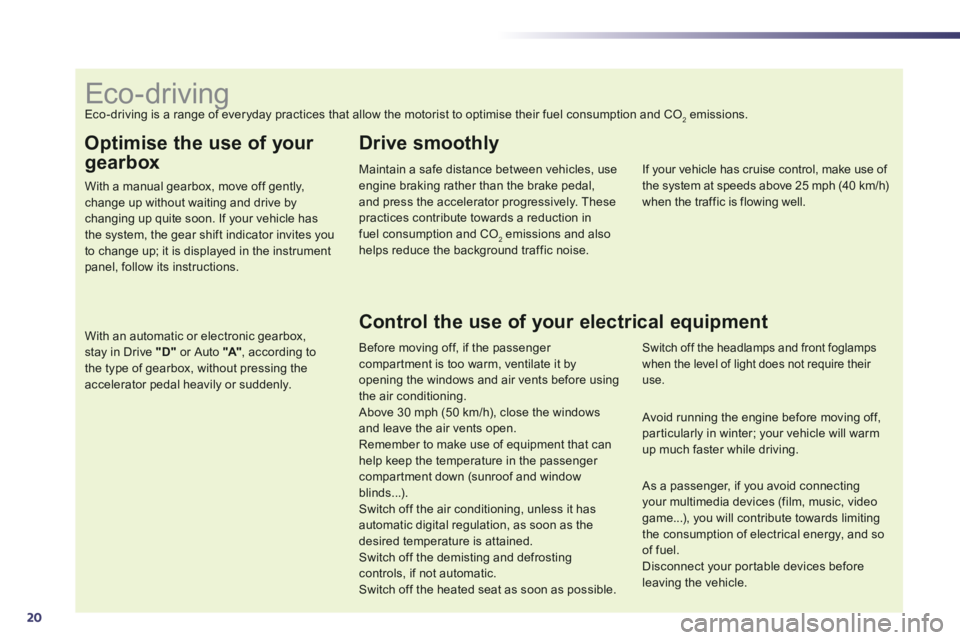
20
Optimise the use of your
gearbox
With a manual gearbox, move off gently, change up without waiting and drive by changing up quite soon. If your vehicle has
the system, the gear shift indicator invites you to change up; it is displayed in the instrument panel, follow its instructions.
With an automatic or electronic gearbox, stay in Drive "D" or Auto "A" , according to the type of gearbox, without pressing the accelerator pedal heavily or suddenly.
Drive smoothly
Maintain a safe distance between vehicles, use engine braking rather than the brake pedal, and press the accelerator progressively. These practices contribute towards a reduction in
fuel consumption and CO2 emissions and also helps reduce the background traffic noise.
If your vehicle has cruise control, make use of the system at speeds above 25 mph (40 km/h) when the traffic is flowing well.
Control the use of your electrical equipment
Before moving off, if the passenger compartment is too warm, ventilate it by opening the windows and air vents before using the air conditioning. Above 30 mph (50 km/h), close the windows and leave the air vents open.
Remember to make use of equipment that can help keep the temperature in the passenger compartment down (sunroof and window blinds...). Switch off the air conditioning, unless it has automatic digital regulation, as soon as the desired temperature is attained. Switch off the demisting and defrosting controls, if not automatic. Switch off the heated seat as soon as possible.
Switch off the headlamps and front foglamps when the level of light does not require their use.
Avoid running the engine before moving off, particularly in winter; your vehicle will warm up much faster while driving.
As a passenger, if you avoid connecting your multimedia devices (film, music, video game...), you will contribute towards limiting the consumption of electrical energy, and so of fuel. Disconnect your portable devices before leaving the vehicle.
Eco-driving Eco-driving is a range of everyday practices that allow the motorist to optimise their fuel consumption and CO2 emissions.
Page 43 of 352
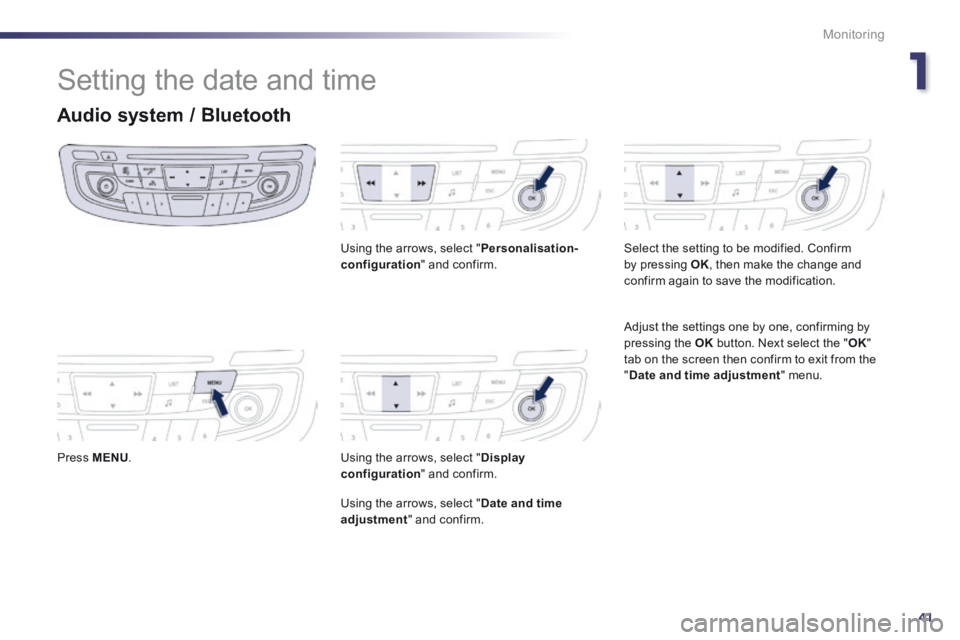
1
41
Monitoring
Setting the date and time
Audio system / Bluetooth
Press MENU .
Using the arrows, select " Personalisation-configuration " and confirm.
Using the arrows, select " Display configuration " and confirm.
Using the arrows, select " Date and time adjustment " and confirm.
Select the setting to be modified. Confirm by pressing OK , then make the change and confirm again to save the modification.
Adjust the settings one by one, confirming by pressing the OK button. Next select the " OK " tab on the screen then confirm to exit from the " Date and time adjustment " menu.
Page 117 of 352
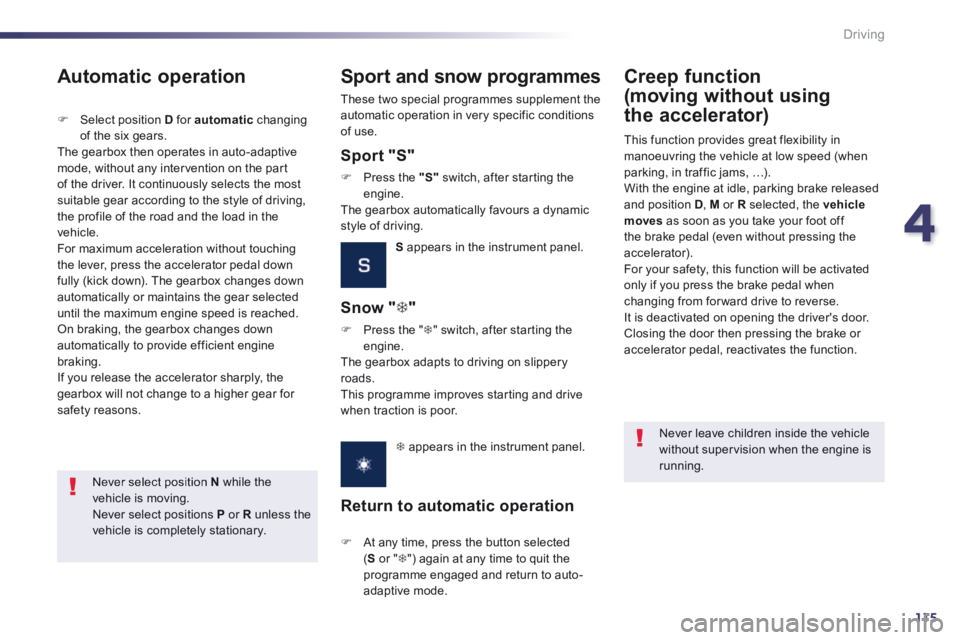
4
115
Driving
Never select position N while the vehicle is moving. Never select positions P or R unless the vehicle is completely stationary.
Automatic operation
Select position D for automatic changing of the six gears. The gearbox then operates in auto-adaptive mode, without any intervention on the part of the driver. It continuously selects the most suitable gear according to the style of driving, the profile of the road and the load in the vehicle. For maximum acceleration without touching the lever, press the accelerator pedal down fully (kick down). The gearbox changes down automatically or maintains the gear selected until the maximum engine speed is reached. On braking, the gearbox changes down automatically to provide efficient engine braking. If you release the accelerator sharply, the gearbox will not change to a higher gear for safety reasons.
Sport and snow programmes
Sport "S"
Press the "S" switch, after starting the engine. The gearbox automatically favours a dynamic style of driving.
S appears in the instrument panel.
Snow " "
Press the " " switch, after starting the engine. The gearbox adapts to driving on slippery roads. This programme improves starting and drive when traction is poor.
appears in the instrument panel.
Return to automatic operation
At any time, press the button selected (S or " ") again at any time to quit the programme engaged and return to auto-
adaptive mode.
These two special programmes supplement the automatic operation in very specific conditions of use.
Creep function
(moving without using
the accelerator)
This function provides great flexibility in manoeuvring the vehicle at low speed (when parking, in traffic jams, …). With the engine at idle, parking brake released and position D , M or R selected, the vehicle moves as soon as you take your foot off the brake pedal (even without pressing the accelerator). For your safety, this function will be activated only if you press the brake pedal when changing from for ward drive to reverse. It is deactivated on opening the driver's door. Closing the door then pressing the brake or accelerator pedal, reactivates the function.
Never leave children inside the vehicle without supervision when the engine is running.
Page 118 of 352
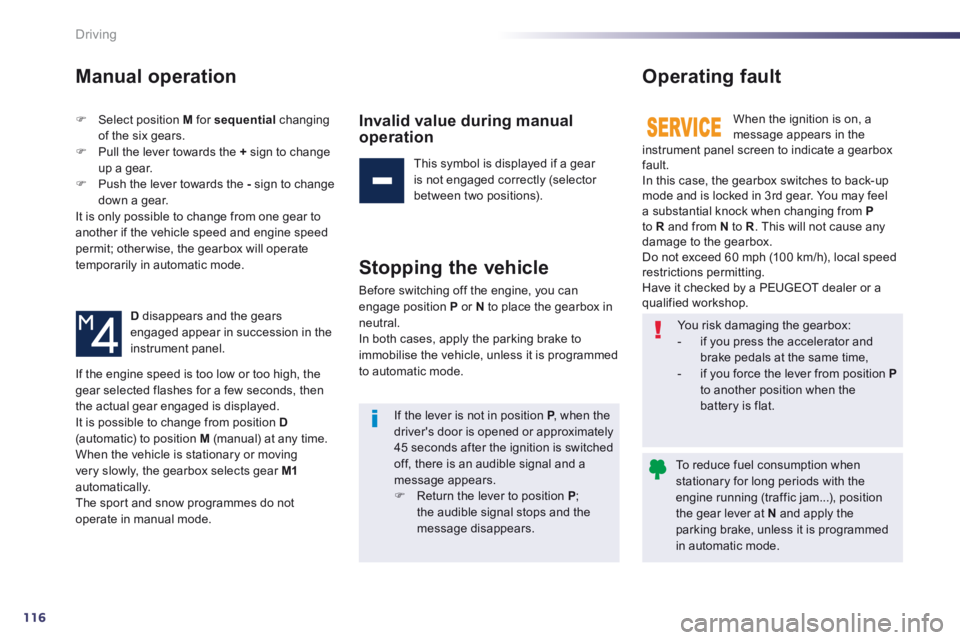
116
Driving
Manual operation
Select position M for sequential changing of the six gears. Pull the lever towards the + sign to change up a gear. Push the lever towards the - sign to change down a gear. It is only possible to change from one gear to another if the vehicle speed and engine speed permit; otherwise, the gearbox will operate temporarily in automatic mode.
D disappears and the gears engaged appear in succession in the instrument panel.
Invalid value during manual operation
This symbol is displayed if a gear is not engaged correctly (selector between two positions).
Stopping the vehicle
Before switching off the engine, you can engage position P or N to place the gearbox in neutral. In both cases, apply the parking brake to immobilise the vehicle, unless it is programmed to automatic mode.
Operating fault
When the ignition is on, a message appears in the instrument panel screen to indicate a gearbox fault. In this case, the gearbox switches to back-up mode and is locked in 3rd gear. You may feel a substantial knock when changing from Pto R and from N to R . This will not cause any damage to the gearbox. Do not exceed 60 mph (100 km/h), local speed restrictions permitting. Have it checked by a PEUGEOT dealer or a qualified workshop.
If the engine speed is too low or too high, the gear selected flashes for a few seconds, then the actual gear engaged is displayed. It is possible to change from position D
(automatic) to position M (manual) at any time. When the vehicle is stationary or moving very slowly, the gearbox selects gear M1automatically. The sport and snow programmes do not operate in manual mode.
You risk damaging the gearbox: - if you press the accelerator and brake pedals at the same time, - if you force the lever from position Pto another position when the battery is flat. If the lever is not in position P , when the P , when the Pdriver's door is opened or approximately 45 seconds after the ignition is switched off, there is an audible signal and a message appears. Return the lever to position P ; the audible signal stops and the message disappears.
To reduce fuel consumption when stationary for long periods with the engine running (traffic jam...), position the gear lever at N and apply the parking brake, unless it is programmed in automatic mode.
Page 144 of 352
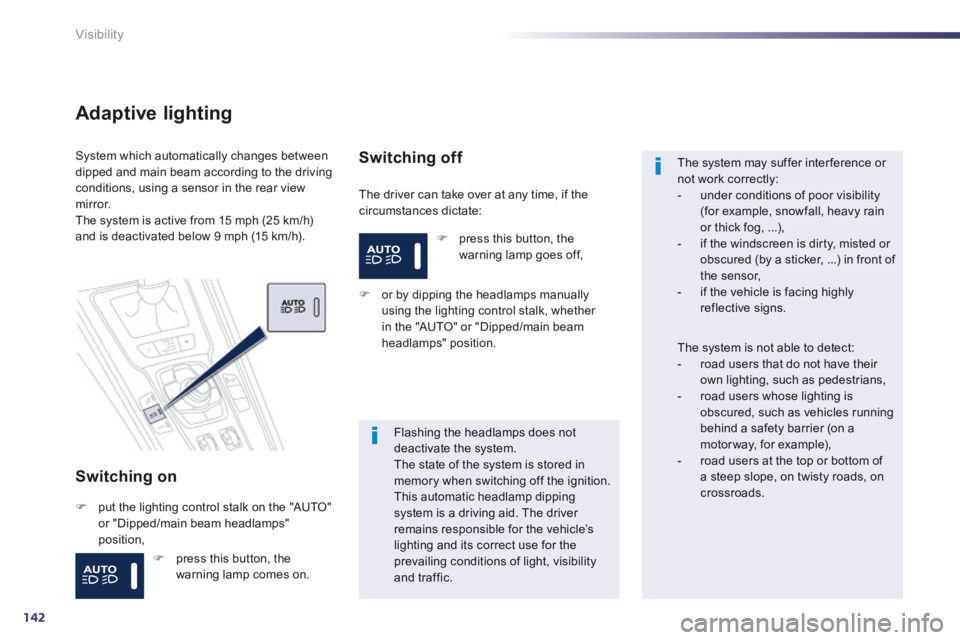
142
Visibility
Adaptive lighting
Switching on
The driver can take over at any time, if the circumstances dictate:
System which automatically changes between dipped and main beam according to the driving conditions, using a sensor in the rear view m i r r o r. The system is active from 15 mph (25 km/h) and is deactivated below 9 mph (15 km/h).
put the lighting control stalk on the "AUTO" or "Dipped/main beam headlamps" position,
Switching off
or by dipping the headlamps manually using the lighting control stalk, whether in the "AUTO" or "Dipped/main beam headlamps" position.
Flashing the headlamps does not deactivate the system. The state of the system is stored in memory when switching off the ignition. This automatic headlamp dipping system is a driving aid. The driver remains responsible for the vehicle’s
lighting and its correct use for the prevailing conditions of light, visibility and traffic.
The system may suffer interference or not work correctly: - under conditions of poor visibility (for example, snowfall, heavy rain or thick fog, ...), - if the windscreen is dirty, misted or obscured (by a sticker, ...) in front of the sensor, - if the vehicle is facing highly reflective signs.
The system is not able to detect: - road users that do not have their own lighting, such as pedestrians, - road users whose lighting is obscured, such as vehicles running behind a safety barrier (on a motor way, for example), - road users at the top or bottom of a steep slope, on twisty roads, on crossroads.
press this button, the warning lamp goes off,
press this button, the warning lamp comes on.
Page 196 of 352

194
Practical information
Sidelamps (halogen model)
Remove the protective plastic cover by pulling on the tab. Unclip the bulb holder. Remove the bulb by pulling it out and change it. For reassembly, carry out these operations in reverse order.
Main beam headlamps (halogen model)
Remove the protective plastic cover by pulling on the tab. Disconnect the bulb connector. Remove the bulb by pulling it out and change it. For reassembly, carry out these operations in reverse order.
Dipped and main beam headlamps (xenon model)
D1S xenon bulbs must be changed by a PEUGEOT dealer or a qualified workshop, as there is a risk of electrocution. It is recommended that the D1S bulbs are changed at the same time when one of them fails.
Daytime running lamps
(xenon model)
For the replacement of these light-emitting diode (LED) lamps, contact a PEUGEOT dealer or a qualified workshop.
Page 197 of 352
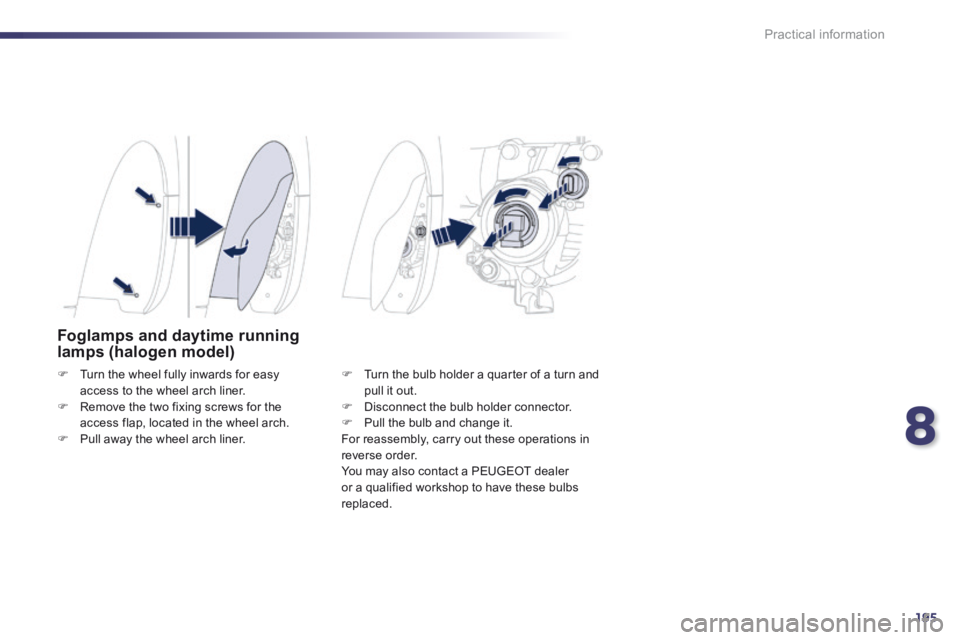
8
195
Practical information
Foglamps and daytime running lamps (halogen model)
Turn the wheel fully inwards for easy access to the wheel arch liner. Remove the two fixing screws for the access flap, located in the wheel arch. Pull away the wheel arch liner.
Turn the bulb holder a quarter of a turn and pull it out. Disconnect the bulb holder connector. Pull the bulb and change it. For reassembly, carry out these operations in reverse order. You may also contact a PEUGEOT dealer or a qualified workshop to have these bulbs replaced.
Page 230 of 352

228
Checks
Checks
12 V battery
The battery does not require any maintenance. However, check that the terminals are clean and correctly tightened, particularly in summer and winter.
Refer to the servicing booklet for details of the replacement intervals for these components.
Air filter and passenger compartment filter
Replace the oil filter each time the engine oil is changed. Refer to the servicing booklet for details of the replacement interval for this component.
Oil filter The presence of this label, in particular with the Stop & Start system, indicates the use of a specific 12 V lead-acid battery with special technology and specification. The involvement of a PEUGEOT dealer or a qualified workshop is essential when replacing or disconnecting the battery.
Particle emission filter (Diesel)
The start of saturation of the particle filter is indicated by the temporary illumination of this warning lamp accompanied by a message in the multi-function screen.
As soon as the traffic conditions permit, regenerate the filter by driving at a speed of at least 40 mph (60 km/h) until the warning lamp goes off. If the warning lamp stays on, this indicates a low additive level.
On a new vehicle, the first particle filter regeneration operations may be accompanied by a "burning" smell, which is per fectly normal. Following prolonged operation of the vehicle at very low speed or at idle, you may, in exceptional circumstances, notice the emission of water vapour at the exhaust on acceleration. This does not affect the behaviour of the vehicle or the environment.
Unless otherwise indicated, check these components in accordance with the servicing booklet and according to your engine. Other wise, have them checked by a PEUGEOT dealer or a qualified workshop.
When carrying out work on the battery, refer to the "12 V battery" section for details of the precautions to be taken before disconnecting the battery and following its reconnection.
Depending on the environment (e.g. dusty atmosphere) and the use of the vehicle (e.g. city driving), replace them twice as often if necessary . if necessary . if necessary A clogged passenger compartment filter may have an adverse effect on the per formance of the air conditioning system and generate undesirable odours.